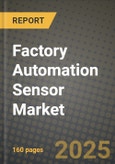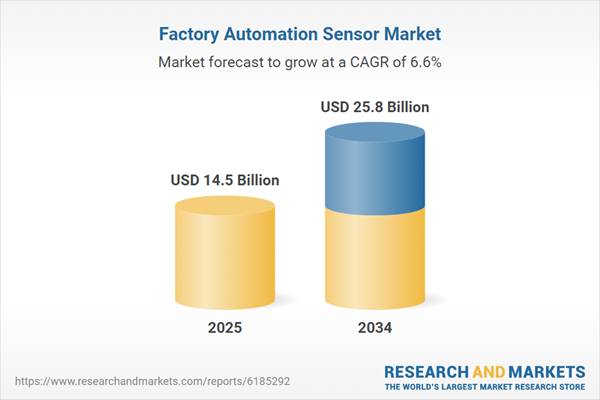Factory Automation Sensor Market Overview
The factory automation sensor market is experiencing rapid growth as industries increasingly adopt smart manufacturing technologies to enhance efficiency, productivity, and quality control. Factory automation sensors, including proximity sensors, vision sensors, pressure sensors, and temperature sensors, play a crucial role in real-time data collection, predictive maintenance, and process optimization. With the rise of Industry 4.0 and the Internet of Things (IoT), manufacturers are integrating advanced sensors into their production lines to enable seamless communication between machines and centralized control systems. The push for energy-efficient, cost-effective, and highly precise automation solutions is driving demand for sensor-based automation across industries such as automotive, electronics, food and beverage, and pharmaceuticals. Additionally, regulatory requirements for workplace safety and quality assurance are further accelerating the adoption of intelligent sensing technologies in factory environments. As global supply chains continue to digitalize, factory automation sensors are becoming integral to improving operational visibility and reducing downtime.the factory automation sensor market has witnessed significant advancements in sensor miniaturization, AI-powered data analytics, and edge computing. The introduction of next-generation industrial sensors with enhanced sensitivity and self-calibration capabilities has improved manufacturing precision and reduced errors. AI-driven predictive maintenance solutions leveraging smart sensors are helping industries minimize unplanned downtime by detecting anomalies before equipment failures occur. The adoption of wireless and battery-free sensor technologies has gained traction, enabling flexible deployment in factories with minimal infrastructure modifications. Additionally, the growing emphasis on cybersecurity in industrial automation has led to the development of encrypted sensor networks that protect factory data from potential breaches. The semiconductor industry's expansion has also contributed to the market’s growth, as the demand for factory automation sensors in chip manufacturing facilities has surged. Moreover, strategic collaborations between sensor manufacturers and industrial automation companies have accelerated innovation, bringing customized sensing solutions to various industrial applications.
The factory automation sensor market is expected to see further integration of artificial intelligence, machine learning, and digital twin technology in sensor-enabled automation. AI-powered sensor networks will enhance real-time monitoring and adaptive process control, enabling fully autonomous production lines. The continued expansion of 5G connectivity in industrial settings will improve data transmission speeds, reducing latency in sensor communication and facilitating seamless machine-to-machine interactions. The development of self-powered sensors using energy-harvesting technology will support sustainable automation, reducing reliance on external power sources. Additionally, the rising adoption of collaborative robots (cobots) in manufacturing will drive demand for advanced vision and proximity sensors capable of ensuring safe human-machine interactions. As industries aim for zero-defect manufacturing and optimized production efficiency, the role of smart sensors in automated quality inspection and process optimization will become even more critical. With increasing government support for digital transformation initiatives, the factory automation sensor market will continue to expand, reshaping modern industrial operations.
Key Insights: Factory Automation Sensor Market
- AI-Driven Predictive Maintenance: The integration of AI with factory automation sensors is enabling predictive analytics, allowing manufacturers to anticipate machine failures and optimize maintenance schedules, reducing downtime and repair costs.
- Miniaturization and High-Precision Sensors: Advances in microelectronics and nanotechnology are leading to the development of ultra-compact sensors with improved accuracy, enabling more efficient and space-saving automation solutions.
- Rise of Wireless and Energy-Harvesting Sensors: Wireless factory automation sensors, powered by energy-harvesting technologies, are reducing dependence on wired installations and external power sources, enhancing system flexibility and sustainability.
- Integration of Digital Twin Technology: The use of digital twins combined with real-time sensor data is enabling virtual simulation and optimization of manufacturing processes, improving productivity and reducing operational risks.
- Enhanced Cybersecurity in Industrial Sensor Networks: As cyber threats in industrial automation grow, manufacturers are adopting encrypted sensor communication protocols and secure data processing frameworks to protect factory infrastructure from cyberattacks.
- Increasing Adoption of Industry 4.0: The push for smart manufacturing and digital transformation across industries is driving the demand for factory automation sensors that enable real-time data collection and automated decision-making.
- Rising Demand for Automated Quality Control: Manufacturers are leveraging high-precision sensors for automated inspection and defect detection, ensuring consistent product quality and compliance with regulatory standards.
- Growing Deployment of Collaborative Robots (Cobots): The rise of cobots in manufacturing is fueling demand for advanced sensing technologies, including 3D vision and proximity sensors, to enable safe and efficient human-machine collaboration.
- Government Initiatives for Smart Manufacturing: Supportive policies and funding programs aimed at accelerating industrial automation adoption are encouraging investments in factory automation sensor technologies worldwide.
- High Initial Investment and Integration Complexity: The cost of deploying advanced factory automation sensors and integrating them with existing manufacturing systems remains a significant challenge for small and mid-sized enterprises, slowing widespread adoption.
Factory Automation Sensor Market Segmentation
By Sensors Type
- Temperature Sensors
- Vibration Sensors
- Humidity Sensors
- Proximity Sensors
- Pressure Sensors
- Vision Sensors
- Other Sensor Types
By Type
- Contact
- Noncontact
By Application
- Manufacturing
- Automotive
- Chemicals
- Energy and Power
- Food and Beverages
- Oil and Gas
- Aerospace and Defense
- Pharmaceuticals
- Other Applications
Key Companies Analysed
- Robert Bosch GmbH
- Siemens AG
- Sony Corporation
- Panasonic Corporation
- Schneider Electric SE
- Honeywell International Inc.
- ABB Ltd.
- STMicroelectronics N.V.
- Infineon Technologies AG
- TDK Electronics Co. Ltd.
- Murata Manufacturing Co. Ltd.
- TE Connectivity Ltd.
- Amphenol Corporation
- Analog Devices Inc.
- Seiko Epson Corporation
- Alps Electric Co. Ltd.
- Rockwell Automation Inc.
- Microchip Technology Inc.
- Omron Corporation
- FANUC Corporation
- Texas Instruments Incorporated
- Vishay Intertechnology Inc.
- Stäubli International AG
- Pepperl+Fuchs SE
- Sensirion AG
Factory Automation Sensor Market Analytics
The report employs rigorous tools, including Porter’s Five Forces, value chain mapping, and scenario-based modeling, to assess supply-demand dynamics. Cross-sector influences from parent, derived, and substitute markets are evaluated to identify risks and opportunities. Trade and pricing analytics provide an up-to-date view of international flows, including leading exporters, importers, and regional price trends.Macroeconomic indicators, policy frameworks such as carbon pricing and energy security strategies, and evolving consumer behavior are considered in forecasting scenarios. Recent deal flows, partnerships, and technology innovations are incorporated to assess their impact on future market performance.
Factory Automation Sensor Market Competitive Intelligence
The competitive landscape is mapped through proprietary frameworks, profiling leading companies with details on business models, product portfolios, financial performance, and strategic initiatives. Key developments such as mergers & acquisitions, technology collaborations, investment inflows, and regional expansions are analyzed for their competitive impact. The report also identifies emerging players and innovative startups contributing to market disruption.Regional insights highlight the most promising investment destinations, regulatory landscapes, and evolving partnerships across energy and industrial corridors.
Countries Covered
- North America - Factory Automation Sensor market data and outlook to 2034
- United States
- Canada
- Mexico
- Europe - Factory Automation Sensor market data and outlook to 2034
- Germany
- United Kingdom
- France
- Italy
- Spain
- BeNeLux
- Russia
- Sweden
- Asia-Pacific - Factory Automation Sensor market data and outlook to 2034
- China
- Japan
- India
- South Korea
- Australia
- Indonesia
- Malaysia
- Vietnam
- Middle East and Africa - Factory Automation Sensor market data and outlook to 2034
- Saudi Arabia
- South Africa
- Iran
- UAE
- Egypt
- South and Central America - Factory Automation Sensor market data and outlook to 2034
- Brazil
- Argentina
- Chile
- Peru
Research Methodology
This study combines primary inputs from industry experts across the Factory Automation Sensor value chain with secondary data from associations, government publications, trade databases, and company disclosures. Proprietary modeling techniques, including data triangulation, statistical correlation, and scenario planning, are applied to deliver reliable market sizing and forecasting.Key Questions Addressed
- What is the current and forecast market size of the Factory Automation Sensor industry at global, regional, and country levels?
- Which types, applications, and technologies present the highest growth potential?
- How are supply chains adapting to geopolitical and economic shocks?
- What role do policy frameworks, trade flows, and sustainability targets play in shaping demand?
- Who are the leading players, and how are their strategies evolving in the face of global uncertainty?
- Which regional “hotspots” and customer segments will outpace the market, and what go-to-market and partnership models best support entry and expansion?
- Where are the most investable opportunities - across technology roadmaps, sustainability-linked innovation, and M&A - and what is the best segment to invest over the next 3-5 years?
Your Key Takeaways from the Factory Automation Sensor Market Report
- Global Factory Automation Sensor market size and growth projections (CAGR), 2024-2034
- Impact of Russia-Ukraine, Israel-Palestine, and Hamas conflicts on Factory Automation Sensor trade, costs, and supply chains
- Factory Automation Sensor market size, share, and outlook across 5 regions and 27 countries, 2023-2034
- Factory Automation Sensor market size, CAGR, and market share of key products, applications, and end-user verticals, 2023-2034
- Short- and long-term Factory Automation Sensor market trends, drivers, restraints, and opportunities
- Porter’s Five Forces analysis, technological developments, and Factory Automation Sensor supply chain analysis
- Factory Automation Sensor trade analysis, Factory Automation Sensor market price analysis, and Factory Automation Sensor supply/demand dynamics
- Profiles of 5 leading companies - overview, key strategies, financials, and products
- Latest Factory Automation Sensor market news and developments
Additional Support
With the purchase of this report, you will receive:- An updated PDF report and an MS Excel data workbook containing all market tables and figures for easy analysis.
- 7-day post-sale analyst support for clarifications and in-scope supplementary data, ensuring the deliverable aligns precisely with your requirements.
- Complimentary report update to incorporate the latest available data and the impact of recent market developments.
This product will be delivered within 1-3 business days.
Table of Contents
Companies Mentioned
- Robert Bosch GmbH
- Siemens AG
- Sony Corporation
- Panasonic Corporation
- Schneider Electric SE
- Honeywell International Inc.
- ABB Ltd.
- STMicroelectronics N.V.
- Infineon Technologies AG
- TDK Electronics Co. Ltd.
- Murata Manufacturing Co. Ltd.
- TE Connectivity Ltd.
- Amphenol Corporation
- Analog Devices Inc.
- Seiko Epson Corporation
- Alps Electric Co. Ltd.
- Rockwell Automation Inc.
- Microchip Technology Inc.
- Omron Corporation
- FANUC Corporation
- Texas Instruments Incorporated
- Vishay Intertechnology Inc.
- Stäubli International AG
- Pepperl+Fuchs SE
- Sensirion AG
Table Information
| Report Attribute | Details |
|---|---|
| No. of Pages | 160 |
| Published | October 2025 |
| Forecast Period | 2025 - 2034 |
| Estimated Market Value ( USD | $ 14.5 Billion |
| Forecasted Market Value ( USD | $ 25.8 Billion |
| Compound Annual Growth Rate | 6.6% |
| Regions Covered | Global |
| No. of Companies Mentioned | 25 |









